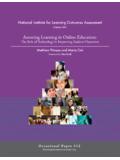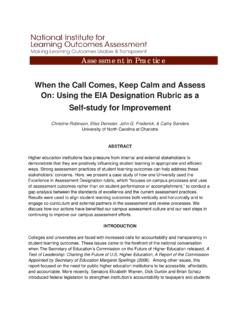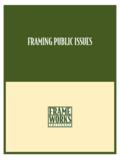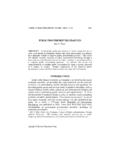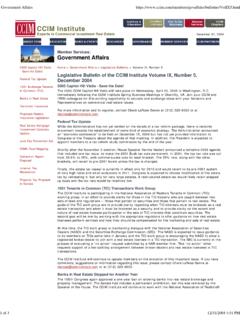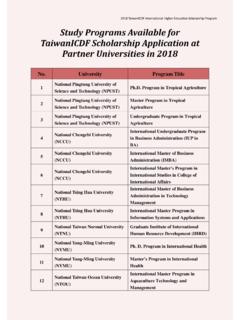Transcription of Making Assessment Meaningful: What New Student …
1 National institute for Learning Outcomes Assessment | 1 Making Assessment Meaningful: What New Student affairs Professionals and Those New to Assessment Need to Know Marilee J. BrescianiNational institute for Learning Outcomes AssessmentAugust 2011 Assessment Brief: Student AffairsFor some professionals in higher education, Assessment seems an onerous task or an add on to an already overloaded schedule. For others, Assessment is a mandate from on high coming with extreme expectations but not the resources to support them. Still others suspect Assessment is a disguise for personnel evaluation or a subtle strategy to impose different values.
2 While such trepidations at the prospect of Assessment are common, implementing meaningful Assessment can go far to allay brief from the National institute for Learning Outcomes Assessment (NILOA) describes what Assessment is intended to be, why the involvement of Student affairs professionals in the Assessment of Student learning and development is critical, and how Student affairs professionals can authentically engage in designing and assessing Student learning on their campuses. When it is implemented by leveraging Student affairs professionals inherent passionate concern for students holistic learning and development, Assessment is experienced as truly integral to the nature of the work of Student affairs professionals fitting easily into their innate inquiry processes and day-to-day AssessmentAssessment begins with simply wondering whether what you do all day is contributing to what you hope your efforts can accomplish.
3 Many Student affairs professionals naturally inquire this way into whether their programs, interventions, curriculum designs, and services are accomplishing what they should. Often, however, because these natural inquiry processes are not organized or systematically implemented, they cannot connect to the larger context of accountability. More and more, campus leaders, the state, accreditors, and the public are asking us to justify the resources we are using and to show what value we are adding to the Student experience (Ewell, 2009; Provezis, 2010). If we do not document what we discover about our programs in ways that are consistent and that others can interpret, we cannot demonstrate how we have used the resources entrusted to us.
4 Assessment , in essence, takes our natural curiosity about our work s effectiveness and puts it in a systematic framework, where we explicitly articulate what we hope a Student participating in a program will take away from the experience the learning outcomes. Once we have described the learning outcomes, we design the program using design tools like concept mapping, curriculum mapping, outcomes delivery mapping, or action planning to best enable the Student to achieve these outcomes. Once we have in place a program based on the desired outcomes, we determine how best to capture with carefully selected Assessment tools and criteria what the Student actually learned or how the Student developed.
5 We then collect the Assessment data and through data analysis and interpretation identify the implications and potential uses of these findings. Next, drawing on the findings, we make decisions and recommendations for revising and improving the program or the Assessment design. If we have the necessary information, we can link these decisions and recommendations to the larger organizational values or strategic initiatives, thus, integrating the accountability of the program with that of the organization. Finally, for the ongoing implementation of Assessment , we determine when the program should be reassessed to see whether our decisions and changes actually brought the desired improvements in learning institute for Learning Outcomes Assessment | 2 How Campus Leadership Engages in Assessing Student Learning The literature1 illustrates several examples of the fine ways in which campus leadership is engaged in assessing Student learning and development (Banta & Associates, 2002; Banta, Jones, & Black, 2009; Bresciani, 2006; Bresciani, Moore-Gardner, & Hickmott, 2009a, 2009b; Kuh, Kinzie, Schuh, Whitt, & Associates, 2005, 2010.)
6 Kuh, Schuh, Whitt, & Associates, 1991; Schuh & Gansemer-Topf, 2010). These books and manuscripts provide excellent ideas and practical strategies, embedded in real life examples, for encouraging faculty, staff, parents, students, and community partners to become fully engaged in Assessment . Some of these strategies need only a foundational knowledge of Assessment to be implemented on your campus. Others are more sophisticated and may require you to become a little more experienced with Assessment , in addition to engaging in collaborative conversations across departments and examining the examples in these books and manuscripts, I noted some similarities among them character-istics that are also reflected, incidentally, in a hallmark document on Assessment , Nine Principles of Good Practice for Assessing Student Learning (American Association for Higher Education, 1991).
7 These characteristics, which you may find helpful when implementing Assessment at your organization, are as follows:1. The focus of Assessment is not on Assessment for Assessment s sake but, rather, on exploring what students are learning and how they are developing in a manner producing evidence that can lead to decisions to improve learning. Instead of conducting a survey, for instance, just to be able to say that Assessment has been done, the examples in these documents use methods and tools that genuinely seek to discover what students are learning and how they are developing. Furthermore, they do so in a manner that contributes to discussions of how to use results to inform decisions that improve program design and, thus, improve Student learning.
8 If the Assessment tool is a survey, as in the instance mentioned above, the survey is aligned directly with the outcomes it is assessing. 2. Learning and development are recognized as dynamic processes in which learning needs to be purposefully facili-tated and not just expected. The Student affairs professionals and faculty in these examples clearly recognize that behavior change does not occur in a one-hour workshop or during one class session. Therefore, that type of learning or development is not represented in the outcomes or Assessment designs. Rather, consis-tent with the latest learning and development theory, Assessment of specified varying levels of learning and development outcomes is aligned with systematically designed and facilitated learning experiences.
9 3. The learning outcomes are clearly and succinctly stated. The learning outcomes are specific, identifi-able, and meaningful to the students, to professionals involved in the program, to the faculty with whom the professionals collaborate, and to the community members that the program is intended to serve. 4. The program design is implemented in such a way that the outcomes should be met if participants engage in the program as the program designers intend. This is the curriculum-mapping or action-planning portion of the project. Reflecting, as previously, the view of learning and development as dynamic, the purposeful design of the program specifies expectations for the achievement of articulated outcomes for which learning oppor-tunities have been provided, rather than for the achievement of outcomes for which students were not provided opportunities to learn.
10 This characteristic removes any arbitrary, unfounded expectation of learning and, instead, purposefully embeds within the design the means for realizing the intended learning outcomes. 5. Because inquiry is ongoing, Assessment being nothing more than inquiry placed into a manageable framework is an ongoing, organized process. To stop questioning whether what we do is working as expected is to invite stagnation and a collapse in creativity and innovation. Without inquiry, learning program problems cannot be solved and Student learning and development cannot improve. Without ongoing inquiry informing decisions and recom-mendations for continuous improvement, we cannot demonstrate our good stewardship of the resources we have been given to facilitate learning and development.
